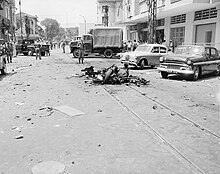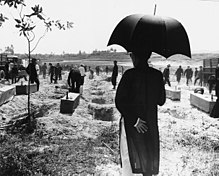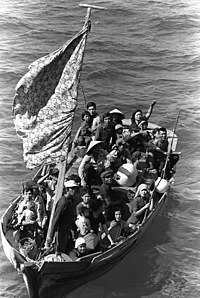| Revision as of 22:10, 8 October 2012 editTheTimesAreAChanging (talk | contribs)Extended confirmed users23,376 edits Hugely misleading← Previous edit | Revision as of 22:12, 8 October 2012 edit undoTheTimesAreAChanging (talk | contribs)Extended confirmed users23,376 edits Grammar, coherence, extra spaces; no need for more emphasis on PP than anything elseNext edit → | ||
| Line 32: | Line 32: | ||
| ====Deaths caused by the American military==== | ====Deaths caused by the American military==== | ||
| The ] was a ] program executed by the United States ] (CIA), ], and the ]'s security apparatus during the ]. It targeted the Viet Cong civilian infrastructure in South Vietnam.<ref>Douglas Valentine 2000 ISBN: 978-0595007387</ref><ref name="otterman-62-64">{{cite book|author=Otterman, Michael|title=American Torture: From the Cold War to Abu Ghraib and Beyond|publisher=Melbourne University Publishing|year=2007|isbn=978-0-522-85333-9|page=62|url=http://books.google.com/books?id=wiVqrgS68NoC&pg=PA62}}</ref> By 1972, 26,369 suspected NLF operatives, informants and supporters were killed.<ref>{{cite book|author=McCoy, Alfred W.|title=A question of torture: CIA interrogation, from the Cold War to the War on Terror|publisher=Macmillan|year=2006|isbn=978-0-8050-8041-4|page=68|url=http://books.google.com/books?id=FVwUYSBwtKcC&pg=PA68}}</ref><ref>{{cite book|author=Harbury, Jennifer|title=Truth, torture, and the American way: the history and consequences of U.S. involvement in torture|publisher=Beacon Press|year=2005|isbn=978-0-8070-0307-7|page=97|url=http://books.google.com/books?id=ZIcZjlj1hLEC&pg=PA97}}</ref> Figures for North Vietnamese civilian dead range from 50,000{{sfn|Rummel|1997}} to 182,000 as a result of US bombing.<ref>{{cite web|url=http://www.pbs.org/battlefieldvietnam/timeline/index2.html |title=Battlefield:Vietnam Timeline |publisher=Pbs.org |accessdate=31 October 2011}}</ref>*A ''Newsweek'' journalist claimed an unnamed official told him that an estimated 5,000 civilians died as "collateral damage" from the American military during ].<ref>Kevin Buckley, "Pacification's Deadly Price," ''Newsweek'' 1972.</ref> ] was used by the U.S. military as part of its ] program, ], during the Vietnam War from 1961 to 1971. ]'s government claimed that 400,000 people were killed or maimed as a result of after effects, and that 500,000 children were born with ].<ref> History.com Retrieved 25/09/12</ref> American forces killed around 5,500 civilians between 1960 and 1972 in democide; Rummel's estimates range from 4,000 to 10,000.<ref> Lines 613]</ref> | |||
| ===Army of the Republic of Vietnam=== | ===Army of the Republic of Vietnam=== | ||
Revision as of 22:12, 8 October 2012

The Vietnam War began in 1955 and ended in 1975 when North Vietnamese forces captured Saigon. During this period the war escalated from an insurgency in South Vietnam sponsored by the North Vietnamese government to direct military intervention in the south by North Vietnam, as well as the active participation of military forces of the United States and other countries. The war also spilled over into the neighbouring countries of Cambodia and Laos. An exhaustive reckoning of the total casualties must include statistical information available for each theater of the war. The casualty figures below focus on Vietnam and exclude those in Cambodia and Laos. The Republic of Vietnam (commonly called South Vietnam) was where most of the fighting took place, and it accordingly suffered most from the war.
Deaths in the Vietnam War
Major incidents

- 1968 Tet Offensive - Hanoi failed in its most ambitious goal of producing a general uprising in the South, it suffered more than 45,267 (mainly Viet Cong) deaths but gained a propaganda, political and strategic victory
- 1972 Easter Offensive - This saw 50,000 to 75,000 North Vietnamese combatants killed plus their loss of over 700 tanks. The attack was broken up mainly by US air power. It was still a North Vietnamese tactical victory.
Civilian deaths in Vietnam war
The Vietnamese government stated in 1995 that a total of 2,000,000 Vietnamese civilians died in the war, but did not divide the deaths between North and South Vietnam. Rummel estimated between 486,000 and 1,200,000 civilians died. Civilians were mistaken for being a member of one side or another and shot. They were sometimes killed simply from being caught up in the midst of a battle and on many occasions they were simply murdered by both sides. South Vietnam suffered the majority of civilians killed. Rummel's review of the various data led to a mid-level estimate of 843,000 civilian deaths in both North and South Vietnam. It was difficult to distinguish between civilians and military personnel on the Viet Cong side since many dressed as civilians
Deaths caused by North Vietnam/VC forces


NVA/VC forces killed around 164,000 civilians in democide between 1954 and 1975 in South Vietnam; Rummel's estimates range from 106,000 to 227,000. Rummel's summary has a mid-level estimate of 17,000 South Vietnamese civil servants (ARVN's local millitia) killed by North Vietnamese forces (including the Viet Cong). In addition, at least 36,000 Southern civilians were executed for various reasons between 1967-1972. Another 50,000 refugees were killed by the NVA during the 1975 Spring Offensive, along with 1,260 civilians during the NVA's shelling of Saigon. About 130 US POWs and 16,000 South Vietnamese POWs died in captivity.
Deaths caused by South Vietnam
During the Diem government (1955–1963), an estimated 80,000 persons died during the forced relocation of 900,000 southern civilians. 4,000 VietCong prisoners died through ill-treatment, about 10,000 suspected VietCong and fighters were executed, and 1,500 civilians died during shellings.
From 1964 to 1975, an estimated 1,500 persons died during the forced relocations of 1,200,000 civilians, another 5,000 prisoners died from ill-treatment and about 30,000 suspected communists and fighters were executed. 6,000 civilians died in the more extensive shellings. In Quang Nam province 4,700 civilians were killed in 1969. This totals 50,000 deaths caused by South Vietnam, excluding North Vietnamese forces killed by the ARVN in combat.
Rummel estimated the government of South Vietnam to be responsible for 90,000 democidal killings from 1954–1975, with a range of 58,000 to 285,000.
Deaths caused by the American military
The Phoenix Program was a counterinsurgency program executed by the United States Central Intelligence Agency (CIA), United States special operations forces, and the Republic of Vietnam's security apparatus during the Vietnam War. It targeted the Viet Cong civilian infrastructure in South Vietnam. By 1972, 26,369 suspected NLF operatives, informants and supporters were killed. Figures for North Vietnamese civilian dead range from 50,000 to 182,000 as a result of US bombing.*A Newsweek journalist claimed an unnamed official told him that an estimated 5,000 civilians died as "collateral damage" from the American military during Operation Speedy Express. Agent Orange was used by the U.S. military as part of its herbicidal warfare program, Operation Ranch Hand, during the Vietnam War from 1961 to 1971. Vietnam's government claimed that 400,000 people were killed or maimed as a result of after effects, and that 500,000 children were born with birth defects. American forces killed around 5,500 civilians between 1960 and 1972 in democide; Rummel's estimates range from 4,000 to 10,000.
Army of the Republic of Vietnam
According to Rummel the Army of the Republic of Vietnam lost between 219,000 at the low end and 313,000 at the high end between 1959 and 1975. Guenter Lewy, from a US Department of Defense document, reported that ARVN suffered 220,357 killed from 1965 through 1974. A PBS estimate was a quarter of a million men killed in action.
North Vietnamese and Viet Cong Military deaths
According to the Vietnamese government, there were 1,100,000 North Vietnamese Army and Viet Cong military personnel deaths during the Vietnam War. Rummel reviewed the many casualty data sets, and this number is in keeping with his mid-level estimate of 1,011,000 North Vietnamese combatant deaths. He further calculated a mid-level estimate of 251,000 Viet Cong military deaths.
United States armed forces
Casualties as of 6 June 2012:
- 58,282 KIA or non-combat deaths (including the missing & deaths in captivity)
- 303,644 WIA (including 153,303 who required hospitalization and 150,341 who didn't)
- 1,664 MIA (originally 2,646)
- 65-119 died in captivity)
Specific incidents

.

- 2,800-6,000 civilians were massacred by the Viet Cong and North Vietnamese forces in the Hue Massacre throughout February, 1968.
- 1,200 civilians were killed by South Korean forces in Tay Vinh massacre between February 12 – March 17, 1966.
- 380 civilians were killed by South Korean forces in Go Dai massacre on February 26, 1966.
- 66 civilians were killed by South Korean forces in Binh Tai massacre on October 9, 1966.
- 280 civilians were killed by South Korean forces in Dien Nien-Phuoc Binh Massacre on October 9, 1966.
- 430 civilians were killed by South Korean forces in Binh Hoa massacre between December 3 and December 6, 1966.
- 79 civilians were killed by South Korean forces in Phong Nhi and Phong Nhat massacre on February 12, 1968.
- 135 civilians were killed by South Korean forces in Ha My massacre on February 25, 1968.
- More than 500 civilians were killed by an American Army company in the My Lai Massacre on March 16, 1968.
- 19 civilians killed by American Forces Feb. 8, 1968 in Quang Nam province.
- 80-90 civilians killed by American Forces March 16, 1968 at My Khe.
- Almost 252 Degar civilians were massacred by the Viet Cong in the Dak Son Massacre on December 5, 1967.
- More than 25,000 South Vietnamese civilians were killed and almost a million become temporary refugees, with over 600,000 interned in South Vietnamese Government camps as a result of North Vietnam's 1972 Easter Offensive.
- At least 81 civilians killed (probably many more) by American Forces, Tiger Force 101st Airborne Division, during the Song Ve Valley and Operation Wheeler military campaigns.
Deaths after U.S. withdrawal

Up to 155,000 refugees fleeing the final NVA Spring Offensive were killed or abducted on the road to Tuy Hoa in 1975. Sources have estimated that 165,000 South Vietnamese died in the re-education camps out of 1-2.5 million sent, while the number executed could have been as high as 200,000 (Jacqueline Desbarats estimates an absolute minimum of 100,000 executions). Rummel estimates that slave labor in the "New Economic Zones" caused 50,000 deaths (out of a total 1 million deported). The number of boat people who died is estimated between 100,000 and 500,000, out of the 2.5 million that fled. There were also tens of thousands of suicides after the North Vietnamese take-over. Including Vietnam's foreign democide, Rummel estimates that a minimum of 400,000 and a maximum of slightly less than 2.5 million people died of political violence from 1975-87 at the hands of Hanoi. In 1988, Vietnam suffered a famine that afflicted millions.
Other nations casualties
South Korea
- 5,099 KIA
- 11,232 WIA
- 4 MIA
Australia
- 426 KIA, 74 died of other causes
- 3,129 WIA
- 6 MIA (All have been accounted for and have been repatriated)
Thailand
- 351 KIA
- 1,358 WIA
New Zealand
- 37 KIA + 2 Civilians
- 187 WIA
Philippines
- 7 men KIA
- 2 men MIA
China 1,446 KIA Soviet Union ~16.
References
- Tran Van Tra, Tet, pp. 49, 50
- "Tet Offensive — History.com Articles, Video, Pictures and Facts". History.com. Retrieved 2012-09-25.
- web site (1997). "North Vietnamese Army's 1972 Eastertide Offensive". web site. Retrieved 2010-02-01.
- David Fulghum & Terrance Maitland, et al, South Vietnam on Trial. Boston: Boston Publishing Company, 1984, tr.183
- ^ Shenon, Philip (23 April 1995). "20 Years After Victory, Vietnamese Communists Ponder How to Celebrate". The New York Times. Retrieved 24 February 2011.
{{cite news}}: More than one of|author=and|last=specified (help) - ^ Associated Press, 3 April 1995, "Vietnam Says 1.1 Million Died Fighting For North."
- Rummel 1997 Line 800
- Willbanks, James H. (2008). The Tet Offensive: A Concise History. New York: Columbia University Press. ISBN 0-231-12841-X.
{{cite book}}: Text "p 32" ignored (help) - Rand Corporation SOME IMPRESSIONS OF VIET CONG VULNERABILITIES AN INTERIM REPORT 1965
- James J. F. Forest Countering Terrorism and Insurgency in the 21st Century 2007 ISBN: 978-0275990343
- Misplaced Pages Đắk Sơn Massacre
- Time Đắk Sơn Massacre Dec. 15, 1967
- Time magazine Moments after Saigon bomb,a torn flag flies 9 Apr 1965
- Rummel 1997
- Michael Lee Lanning and Dan Cragg, Inside the VC and the NVA, (Ballantine Books, 1993), pp. 186-188
- Rummel 1997, Lines 448, 454, 456 and 464.
- Rummel 1997, Lines 457 & 459.
- Rummel 1997 Lines 481, 494, 515, 518, 521]
- Vietnam: Why Did We Go?" by Avro Manhattan, Chick Publication, California 1984, pp. 56 & 89
- Rummel 1997 Lines 540, 556, 563, 566, 569, 575
- Rummel 1997 Lines 626]
- Douglas Valentine The Phoenix Program 2000 ISBN: 978-0595007387
- Otterman, Michael (2007). American Torture: From the Cold War to Abu Ghraib and Beyond. Melbourne University Publishing. p. 62. ISBN 978-0-522-85333-9.
- McCoy, Alfred W. (2006). A question of torture: CIA interrogation, from the Cold War to the War on Terror. Macmillan. p. 68. ISBN 978-0-8050-8041-4.
- Harbury, Jennifer (2005). Truth, torture, and the American way: the history and consequences of U.S. involvement in torture. Beacon Press. p. 97. ISBN 978-0-8070-0307-7.
- ^ Rummel 1997. Cite error: The named reference "FOOTNOTERummel1997" was defined multiple times with different content (see the help page).
- "Battlefield:Vietnam Timeline". Pbs.org. Retrieved 31 October 2011.
- Kevin Buckley, "Pacification's Deadly Price," Newsweek 1972.
- History.com Operation Ranch Hand and Agent Orange Retrieved 25/09/12
- Rummel 1997 Lines 613]
- Battlefield:Vietnam | Timeline
- Rummel 1997, Line 102.
- Rummel 1997, Line 83.
- Ten New Names Added To Vietnam Veterans Memorial Wall
- US Military Operations: Casualty Breakdown
- "Vietnam-era unaccounted for statistical report" (PDF). 6 June 2012.
- U. S. DEPARTMENT OF VETERANS AFFAIRS
- American Vietnam War Casualty Statistics
- New York Times Hue Massacre of 1968 Goes Beyond Hearsay September 22, 1987
- Time magazine THE MASSACRE OF HUE Oct. 31, 1969
- "Report of the Department of Army review of the preliminary investigations into the Mỹ Lai incident. Volume III, Exhibits, Book 6—Photographs, 14 March 1970". From the Library of Congress, Military Legal Resources.
- "My Lai", Original broadcast PBS American Experience, 9 pm, April 26, 2010 Time Index 00:35' into the first hour (no commercials)
- Anderson, David L. The Columbia Guide to the Vietnam War. 2004, page 98-9
- ^ Words of Condemnation and Drinks of Reconciliation 2/09/99 Retrieved 25/09/12
- Armstrong, Charles (2001). Critical asian studies, Volume 33, Issue 4 Page 530 :America's Korea, Korea's Vietnam.
- Gerassi, John (1968). North Vietnam: a documentary.p.148 Bobbs-Merrill.
- "On War extra - Vietnam's massacre survivors". AlJazeera. 2009-01-04. Retrieved 2011-07-09.
- BBC News Murder in the name of war - My Lai 20 July, 1998 Retrieved 25/09/12
- LA Times Civilian Killings Went Unpunished August 6, 2006 Retrieved 26/09/12
- LA Times Verified Civilian Slayings August 6, 2006 Retrieved 26/09/12
- Andrade, p. 529.
- Toledo Blade Rogue GIs unleashed wave of terror in Central Highlands 10/19/2003, Retrieved 23/09/12
- Nghia M. Vo The Vietnamese Boat People, 1954 and 1975-1992,ISBN: 978-0-7864-2345-3, 2006
- Lawrence Lam,York University [http://pi.library.yorku.ca/ojs/index.php/refuge/article/viewFile/21589/20262 The Attitude of the Local Population Towards Vietnamese Boat People in Hong Kong] Feb 1990
- Wiesner, Louis, Victims and Survivors: Displaced Persons and Other War Victims in Viet-Nam, 1954-1975 (Greenwood Press, 1988), pp. 318-9.
- ^ Desbarats, Jacqueline. "Repression in the Socialist Republic of Vietnam: Executions and Population Relocation", from The Vietnam Debate (1990) by John Morton Moore. "We know now from a 1985 statement by Nguyen Co Tach that two and a half million, rather than one million, people went through reeducation....in fact, possibly more than 100,000 Vietnamese people were victims of extrajudicial executions in the last ten years....it is likely that, overall, at least one million Vietnamese were the victims of forced population transfers."
- Anh Do and Hieu Tran Phan, Camp Z30-D: The Survivors, Orange County Register, April 29, 2001.
- Al Santoli, ed., To Bear Any Burden (Indiana University Press, 1999), pp272, 292-3.
- Morris, Stephen J. Glastnost and the Gulag: The Numbers Game, Vietnam Commentary, May–June 1988.
- ^ Rummel, Rudolph, Statistics of Vietnamese Democide, in his Statistics of Democide.
- Nghia M. Vo, The Vietnamese Boat People, 1954 and 1975-1992 (McFarland, 2006).
- Crossette, Barbara, Hanoi, Citing Famine Fears, Seeks Emergency Aid, The New York Times, May 15, 1988.
- ^ KOREA military army official statistics, AUG 28, 2005
- "Vietnam War, 1962-72 - Statistics". Australian War Memorial. 2003. Retrieved 2008-02-04.
{{cite web}}: Cite has empty unknown parameter:|coauthors=(help) - The Encyclopedia of the Vietnam War: A Political, Social, and Military History By Spencer C. Tucker "http://books.google.com.au/books?id=qh5lffww-KsC&lpg=PA53&dq=the%20encyclopedia%20of%20the%20vietnam%20war%20page%2064&pg=PA176&output=embed"
- "New Zealand Rolls Of Honour - By Conflict". Freepages.genealogy.rootsweb.ancestry.com. Retrieved 2012-09-25.
- "Overview of the war in Vietnam | VietnamWar.govt.nz, New Zealand and the Vietnam War". Vietnamwar.govt.nz. 1965-07-16. Retrieved 2012-09-25.
- James F. Dunnigan; Albert A. Nofi (2000). Dirty Little Secrets of the Vietnam War: Military Information You're Not Supposed to Know. Macmillan. ISBN 0-312-25282-X.
External links
- National Archives AAD Searchable database.
- The Vietnam Center and Archive. Texas Tech University.